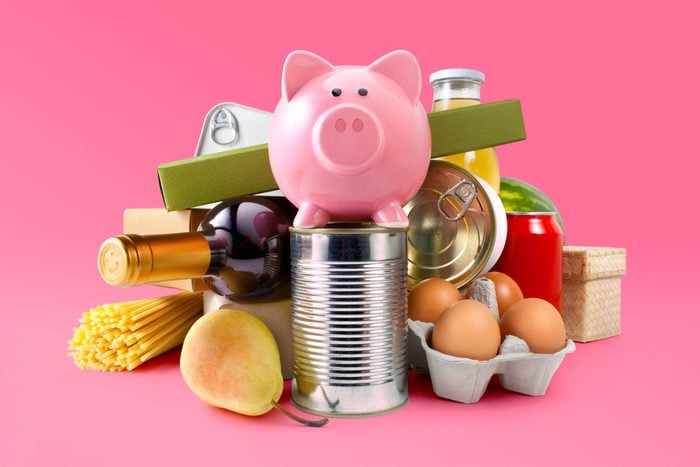
Shop smarter with this budget grocery list
As you probably know all too well, the cost of groceries has been steadily rising over the last year, and there’s no end in sight. According to the U.S. Department of Agriculture’s Economic Research Service, grocery prices were 12.4% higher in October 2022 than they were in October 2021. To put that in perspective, the average cost for a gallon of milk in 2021 was $3.77. It’s now $4.41, and that’s just for conventional whole milk. Shoppers who prefer organic milk are paying an average of $4.74 per half gallon of whole milk compared to the $4.24 they paid a year ago. Unfortunately, there’s not much you can do about rising prices, but there are ways to save money and stretch your grocery budget without sacrificing healthy foods. One of the best things to do? Make a budget grocery list before each shopping trip.
Sure, things like clipping coupons, meal planning, using grocery shopping apps and following tips to save money on groceries are helpful, but they can require a considerable amount of time and effort. If you’re looking for an easy starting point, a budget grocery list will be right up your alley. And no, we’re not talking about skipping the good stuff and heading straight for cheap snacks. Each food group has certain foods that are generally less expensive and more versatile, making it easier than you think to get a healthy lifestyle on a budget. More importantly, these common foods are available at all the affordable grocery stores. Happy shopping!
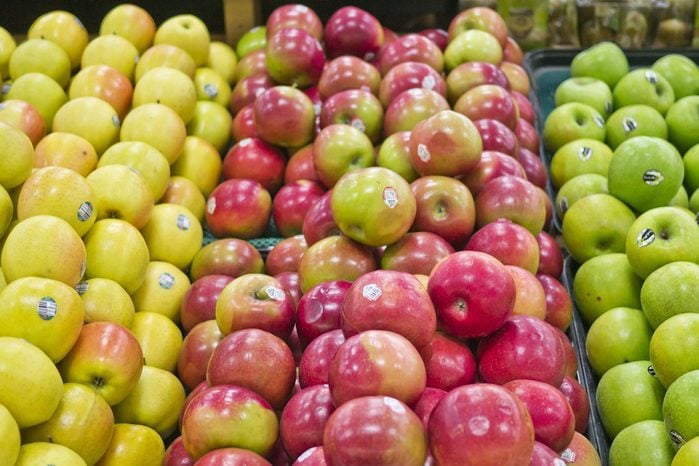
Fruits
Fresh fruits like apples, bananas and oranges are known for being incredibly affordable. Plus, according to the USDA, if you’re looking for cheap fruit options, buying seasonal produce is always your best bet since a more abundant supply is able to meet consumer demand. Not only that, but that’s when these fruits will be at their best in terms of taste.
Want to enjoy your favorite fruit out of season? Opt for a large bag from the freezer section of your grocery store when it’s on sale. A bag of frozen strawberries will cost about the same no matter what the season, though you’ll generally get more for your money if you buy frozen instead of fresh. Buying frozen fruit on sale and/or in bulk will only add to your savings. Pro tip: A vinegar fruit wash can make your produce last longer and make it cleaner.
Spring
- Kiwi
- Pineapples
- Strawberries
Summer
- Blackberries
- Blueberries
- Cantaloupe
- Cherries
- Honeydew melon
- Peaches
- Plums
- Raspberries
- Strawberries
- Watermelon
Fall
- Apples
- Cranberries
- Grapes
- Pears
- Raspberries
Winter
- Grapefruit
- Kiwi
- Oranges
- Pineapples
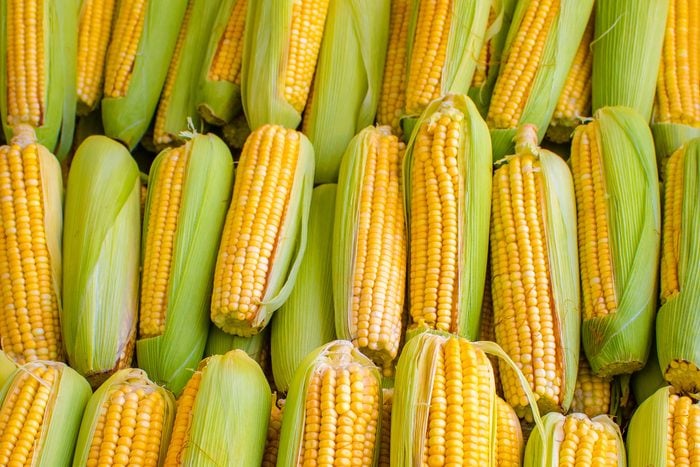
Vegetables
Broccoli, carrots, onions, celery and potatoes tend to be cheap year-round. But as with fruits, if you want more variety, opt for fresh vegetables that are in season. If you’re on a budget, it’s also a good idea to stock up on canned or frozen veggies when your grocery store runs a good sale. While the price of frozen vegetables tends to remain steady all year long, you will often get better prices than if you buy these items fresh. And, of course, frozen and canned food also lasts for a while, so don’t be shy when you spot a fantastic deal! If you’re putting fresh items in the fridge, make sure you know which fruits and vegetables you shouldn’t store together.
Spring
- Asparagus
- Lettuce
- Mushrooms
- Peas
- Spinach
Summer
- Beets
- Bell peppers
- Corn
- Cucumbers
- Eggplant
- Green beans
- Summer squash
- Tomatoes
- Zucchini
Fall
- Brussels sprouts
- Cauliflower
- Parsnips
- Sweet potatoes and yams
- Turnips
Winter
- Kale
- Leeks
- Rutabagas
- Sweet potatoes and yams
- Swiss chard
- Turnips
- Winter squash
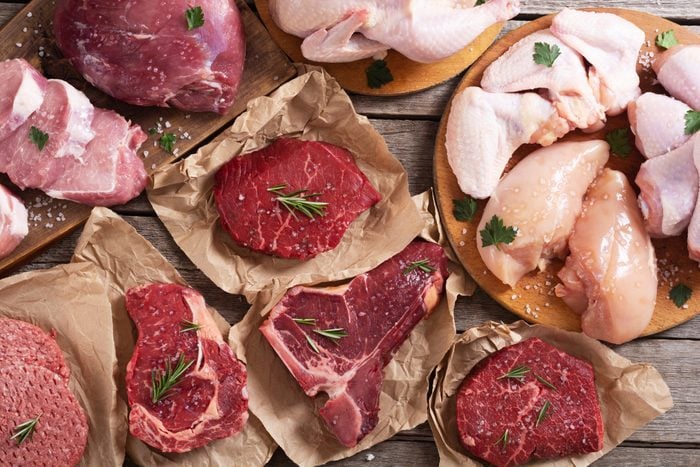
Meats
According to the USDA, the cost of meat was 16.9% higher in October 2022 than it was in October 2021. While a juicy rib eye or tender prime-rib roast may no longer fit into your budget, there’s plenty of cheap meat that will. Consider purchasing ground meats, which are more affordable than premium cuts, versatile and easy to buy in bulk and freeze.
Want to save on chicken? Select a whole chicken instead of pre-portioned cuts. You can have roast chicken for dinner one night, then use the leftovers for chicken soup and salad; you can even use the carcass to make a pot of bone broth. If you don’t want the whole chicken, opt for regular chicken breasts over thinly sliced options, which are often more expensive per pound. Don’t forget: You’re paying for the convenience! But it’s easy enough to slice a regular chicken breast yourself and pound it into thin cutlets with a meat mallet.
Another smart idea: Stock up on your favorite cuts when they’re in season. And yes, meats do have in-season months. For example, corned beef is cheapest in the spring, hamburger meat is cheapest during the summer and turkey is at its cheapest in the fall and winter months. And if you have leftovers, follow these meat-storage guidelines to avoid having to throw anything away.
Here are some other cheap cuts of meat you can incorporate into your diet:
- London broil
- Stew meat
- Top round roast
- Pork shoulder
- Pork butt
- Lamb shoulder
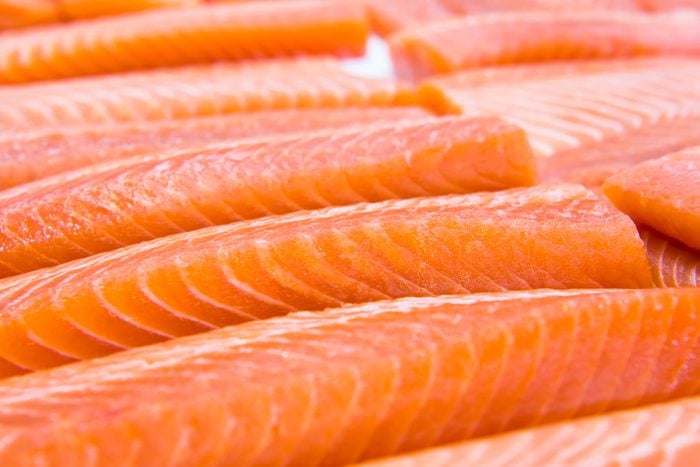
Fish
Eating seafood twice a week offers a multitude of health benefits ranging from better brain and eye development to a lower risk of heart disease. But market price is rarely a bargain. When it comes to shopping for seafood on a budget, the Seafood Nutrition Partnership recommends opting for sustainable species, which currently include the following:
- Cod
- Flounder
- Alaska pollock
- Salmon (Alaskan salmon will be cheapest during the early summer months when the fish are plentiful)
- Shrimp
- Mussels
- Canned tuna
- Sardines
Keep in mind that sustainable species change—and somewhat often. Sustainability can also depend on where the fish is from, how it was caught and other factors. To be sure you’re purchasing sustainable seafood, check Seafood Watch’s Latest Updates page before you shop.
Another way to save money on fish is to buy frozen. The Seafood Nutrition Partnership points out that frozen seafood is a budget-friendly option that can be bought in bulk and stored. Additionally, a large package of frozen fish makes a quick, family-friendly meal because it can go from frozen to cooked in mere minutes.
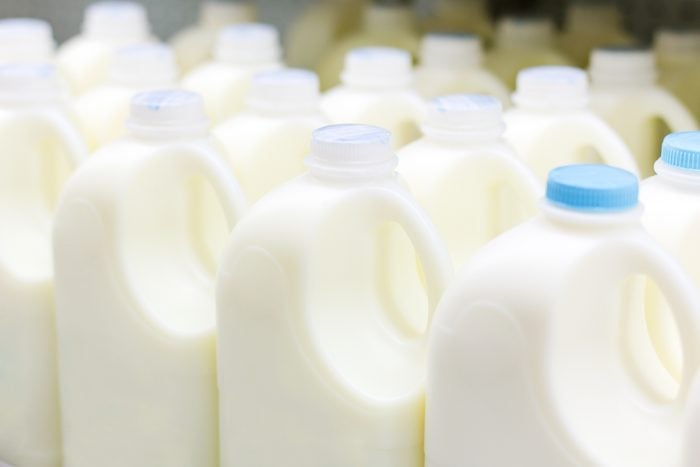
Dairy
Dairy products, which include things like milk, eggs, butter and cheese, have all risen in price. When it comes to saving money on these refrigerator staples, start by choosing store-brand products over name-brand ones, and consider buying certain items in bulk as opposed to individually packaged portions. For instance, getting a store-brand block of cheese and cutting it up for a snack will be cheaper than buying prepackaged cheese snacks. Similarly, buying a 32-ounce container of plain or vanilla yogurt and jazzing up your portion with fresh or frozen berries is more cost-effective than purchasing individual containers of flavored yogurt. Plus, it will have less added sugar!
Here are the best budget grocery list items from the dairy aisle:
- Store-brand butter (buy in bulk when on sale since it’s easily frozen)
- Store-brand eggs
- Store-brand milk
- 32-ounce containers of plain or vanilla yogurt
- 8-ounce blocks of store-brand cheeses, which can be cut or grated as needed
Also consult our handy guides to learn how long milk, butter, eggs and other foods last in the fridge.
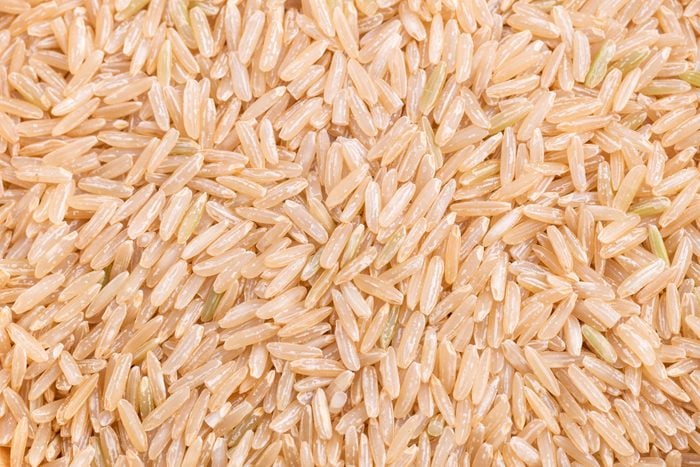
Grains
Incorporating grains into your diet comes with a number of health benefits. They provide complex carbohydrates, dietary fiber and a host of vitamins and minerals. Eating whole grains also helps reduce your risk of heart disease and neural-tube birth defects (if you’re pregnant) and promotes healthy digestion, according to the USDA. Luckily, whole grains, which offer more nutritional value than their refined cousins, are fairly inexpensive to buy in bulk. And some, like popcorn, even make for a satisfying and cheap snack. Refined grains are also a cheap food to add to your weekly meal rotation, though you may want to do so in moderation. Making a hearty oatmeal for breakfast, serving your protein over rice or adding couscous to your favorite soup are great ways to fill up your family for less.
Whole grains
- Brown rice
- Oatmeal (opt for a canister of old-fashioned oats, which is cheaper and has less sugar than prepackaged instant oatmeal)
- Popcorn
- Quinoa
- Wild rice
Refined grains
- Couscous
- Cream of rice
- Cream of wheat (again, avoid instant packets, which are more expensive and have a high sugar content)
- Pasta
- Pretzels
- White rice
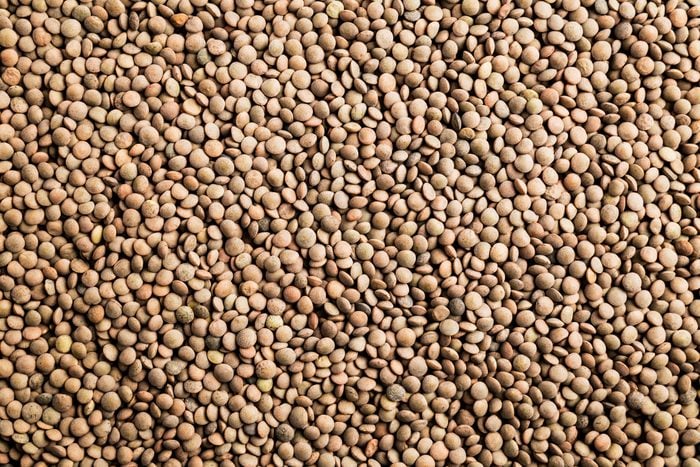
Pantry staples
In order to whip up nutritious meals, you’ll have to keep a supply of certain items in your pantry. Having the following ingredients on hand will allow you to create inexpensive meals like soups, casseroles and other favorite dishes. Many of the following items are as nutritious as they are affordable, while others will help foods rise, thicken or otherwise come together for a budget-friendly meal. Many of these nonperishable items also have long shelf lives, which will help you reduce food waste.
- Baking powder
- Baking soda
- Beans
- Bullion (an affordable alternative to canned or boxed broth)
- Flour
- Lentils
- Peanut butter
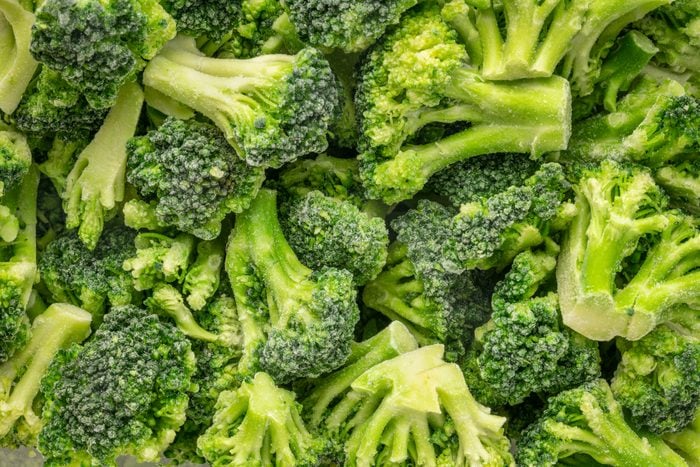
Frozen foods
Frozen foods, especially prepared meals, can be costly. But having a few freezer staples can help you create a variety of healthy meals for less, as noted earlier with frozen fruits and veggies. For instance, fresh broccoli can cost around $2 per crown, while an entire bag of frozen florets costs around $2.50 and can last a few months in your freezer.
And that’s not all: Pie crusts are also great to have on hand for a quick quiche or pot pie. A homemade quiche using frozen pie crusts and broccoli from your freezer, along with cheese and eggs from your fridge, can cost you well under $10. Meanwhile, a premade broccoli cheddar cheese quiche from Whole Foods can set you back a whopping $19.99.
The following freezer items are both affordable and convenient to have on hand. And as always, keep an eye out at your favorite grocery store for deals!
- Berries
- Broccoli
- Chopped spinach
- Corn
- Green beans
- Mixed vegetables
- Pie crusts
While we’re on the subject, here’s how to freeze almost every type of food.
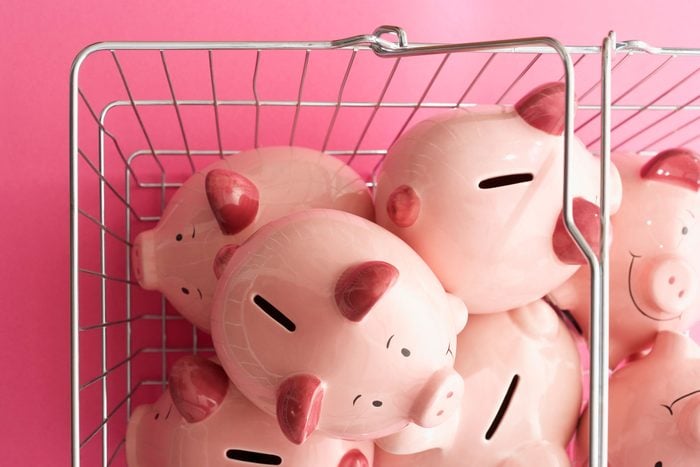
How to find cheap groceries
These days, finding ways to save money on groceries is no easy feat. It requires more time and effort than just making a budget grocery list and heading to your favorite supermarket. However, once you find a system that works for you, it will quickly become second nature. Try the following tips and tricks to save—and no, they don’t involve complicated couponing! That said, if you want to learn how to coupon and how to get coupons, we’ve got you covered there too.
- Meal plan. Creating a meal plan and making a list of the exact items you need each week ensures you buy only what you need.
- Download your local grocery stores’ apps. Check the weekly flier for each store to see which one is offering the best prices on the items you need that week. Then download one of the best budget apps to help you stay on track.
- Kiss brand loyalty goodbye. In most instances, store brands are cheaper and just as good as name-brand items. For example, a half gallon of Lactaid will set you back $4.99 at Stop & Shop, while a half gallon of store-brand lactose-free milk is $3.69.
- Consider shopping at private-label stores. Aldi and Trader Joe’s are both known for offering quality foods at lower prices. That lactose-free milk we just discussed? You can snag a half gallon for $2.99 at Aldi. And in case you were wondering, here’s why Aldi’s and Trader Joe’s groceries are so cheap.
- Buy in bulk. Items that can be frozen or pantry staples with a long shelf life can be more cost-effective. What you buy depends on your family, but we’ve found that frozen veggies and oats are two of the best things to buy in bulk. Frozen vegetables are jam-packed with nutrients and can last at least six months in the freezer. Oats, on the other hand, have a shelf life of up to 12 months when properly stored and are both incredibly versatile and nutritious. Whip up overnight oats, baked oatmeal and oats cooked according to package directions, as well as a variety of yummy baked goods!
- Avoid prepared foods. Though they can be super convenient, prepared foods will cost you more money.
- Forgo Instacart and other online shopping services. While shopping online can help you avoid impulse purchases, these groceries are likely marked up. Plus, you may have to pay a fee and/or tip your delivery person, which can take a chunk out of your grocery budget. While these convenience services are among the things that will be cheaper in 2023, your groceries will still be less expensive if you skip the services altogether.
Get Reader’s Digest’s Read Up newsletter for humor, cleaning, travel, tech and fun facts all week long.
Sources:
- Butcher Magazine: “Cheaper Cuts of Meat for Home Cooks to Try — Staying on Budget Without Sacrificing Flavor”
- Seafood Nutrition Partnership: “Eating and Buying Seafood on a Budget”
- USDA My Plate: “Grains”
- USDA Economic Research Service: “Summary Findings: Food Price Outlook, 2022 and 2023”
- USDA Agricultural Marketing Service: “Retail Milk Prices Report”
- USDA SNAP-Ed Connection: “Seasonal Produce Guide”
- Cereals & Grains Association: “Shrinking the Price Gap for Whole Grains”
